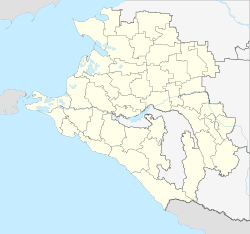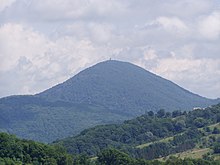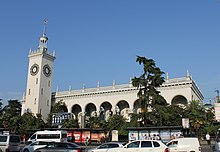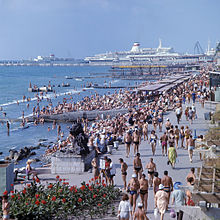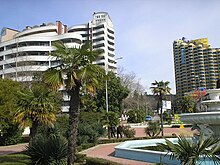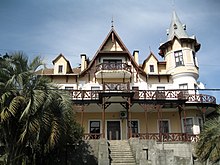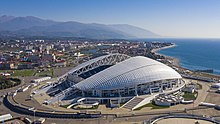Sochi
| city
Sochi
Сочи
|
||||||||||||||||||||||||||||||||||||||||||
|
||||||||||||||||||||||||||||||||||||||||||
|
||||||||||||||||||||||||||||||||||||||||||
| List of cities in Russia | ||||||||||||||||||||||||||||||||||||||||||
Sochi ( Russian Сочи , , scientific transliteration Soči ) is a city and district on the Black Sea in Russia . Sochi is located in the southern Russian region of Krasnodar near the border with Georgia and Abkhazia and has 343,334 inhabitants (as of October 14, 2010).
Sochi is one of the most popular bathing and health resorts in Russia: the area around the city is often referred to as the “ (Russian) Black Sea Riviera ”. The city is also the seat of a university.
geography
location
The urban district of Sochi stretches for about 100 kilometers as the crow flies along the north-eastern coast of the Black Sea. The north-western border is the Sheepsi river a few kilometers south of Tuapse , and the south-eastern border is the Psou river , which also forms the border between Russia and Georgia , or the republic of Abkhazia , which breaks away from Georgia and is recognized by only a few states, including Russia . The city center of Sochi is about 30 kilometers away from the border.
The first mountain range of the Caucasus near the coast with the Alek , Bytcha , Mamaiski , Soloniki and Tjupjutschch ridges reaches heights of around 1000 m and is responsible for the mild winter climate. The mountains of the main Caucasus ridge, 25 to 40 kilometers from the coast, are over 3000 meters high here (Zachwoa, 3345 m ).
On the territory of the city of Sochi, several mountain rivers that cut the first mountain range reach the Black Sea. From north to south these are Psesuapse , Schache , Sochi and Msymta .
City organization and administration
overview
On February 10, 1961, two neighboring Rajons , Lasarewskoje and Adler , were incorporated, creating the administrative structure that exists today and is sometimes called Greater Sochi (Bolshoi Sotschi) . In 1959 the incorporated Rajons Adler and Lasarewskoje had 55,273 and 37,389 inhabitants, of which the urban-type settlements Adler 19,658, Lasarewskoje 8966, Dagomys 7192 and Krasnaya Polyana 4443 inhabitants.
Today the city is divided into four districts (Rajons): Lasarewski Rajon, Zentralny Rajon, Hostinski Rajon and Adlerski Rajon (order from northwest to southeast). The urban district also includes the urban-type settlement Krasnaya Polyana (Russian for red or beautiful clearing ) in the Adler district with 3972 inhabitants and 78 villages with a total of 69,068 inhabitants, so that the total population of the urban district of Sochi is almost 438,000 (2012 calculation). The urban district also includes extensive, practically uninhabited mountain areas.
Stadtrajone

in the background the Caucasus
| Stadtrajon | Russian | Area (km²) | Population census 2010-10-14 |
Districts | # |
|---|---|---|---|---|---|
| Zentralny Rajon | Центральный район | 32 | 137.677 | Sochi (center) | 1 |
| Khostinsky district | Хостинский район | 374 | 65.229 | Chosta, Kudepsta, Mazesta | 2 |
| Lazarevsky Rajon | Лазаревский район | 1,744 | 63.894 | Ash, Dagomys , Jakornaja Schchel, Loo, Magri, Makopse, Lasarewskoje, Soloniki, Wardane | 3 |
| Adlersky Rajon | Адлерский район | 1.352 | 76,534 | Adler , Krasnaya Polyana | 4th |
| year | Residents |
|---|---|
| 1897 | 1,352 |
| 1926 | 13,000 |
| 1939 | 49,813 |
| 1959 | 95.234 |
| 1970 | 224.031 |
| 1979 | 287.353 |
| 1989 | 336,514 |
| 2002 | 328,809 |
| 2010 | 343,334 |
| Census data (1926 rounded) | |
population
Today the population of Sochi is multicultural and is made up of members of numerous ethnic groups. At the 2002 census, in addition to Russians (67.5% of the population), Armenians (20.2%), Ukrainians (3.7%), Georgians (2.4%), Circassians (1.2%) lived in Sochi. , Greeks (1%), Belarusians (0.7%), Tatars (0.5%), as well as members of numerous other minorities, including Azerbaijanis , Abkhazians , Ossetians and Germans (mostly Russian- Germans ).
In addition to the Russian majority population, the Armenian minority is particularly important; they have settled in the Sochi area in several waves of migration since the 19th century. In the Loo district of Sochi as well as in the area around the city there are a few settlements predominantly inhabited by Armenians. The population of Sochi has not only grown rapidly since the end of the 19th century, but has also changed significantly in terms of ethnic composition. According to the Russian census of 1897, 25.7% of the population of Sochi were Greeks , 24.2% Russians, 13.8% Circassians, 11.3% Estonians, 10.8% Moldovans and 10.6% Georgians. Most of the non-Russian residents assimilated to the Russian population during the 20th century. In the summer, Sochi's permanent population is joined by tourists and numerous seasonal workers.
climate
| Sochi | ||||||||||||||||||||||||||||||||||||||||||||||||
|---|---|---|---|---|---|---|---|---|---|---|---|---|---|---|---|---|---|---|---|---|---|---|---|---|---|---|---|---|---|---|---|---|---|---|---|---|---|---|---|---|---|---|---|---|---|---|---|---|
| Climate diagram | ||||||||||||||||||||||||||||||||||||||||||||||||
| ||||||||||||||||||||||||||||||||||||||||||||||||
|
Average monthly temperatures and rainfall for Sochi
Source:
|
|||||||||||||||||||||||||||||||||||||||||||||||||||||||||||||||||||||||||||||||||||||||||||||||||||||||||
Sochi is on the same latitude as Nice . The climate of the Sochi coastal zone is subtropical with long, hot summers, warm autumns and short, mild winters. The reason for this is the sheltered location by the Caucasus ridges approaching the sea, which, however, also cause a relative abundance of precipitation.
The annual mean temperature is around 14 ° C. Coldest months are January and February with about 6 ° C, warmest months July and August with about 23 ° C. The lowest temperature ever measured was −13.4 ° C (January 25, 1892), the highest 39.4 ° C (July 30, 2000). In January, however, 21.2 ° C were measured (January 22, 1948), while the temperatures in July / August have never fallen below 10 ° C.
The average water temperature of the Black Sea in August is 24.1 ° C.
The average annual rainfall is over 1600 mm (for comparison Berlin : 581 mm). Much of this falls in the winter months with a maximum of around 190mm in December and January. The summer minimum in May to June of 90 to 100 mm is usually down in heavy rain on only a few days.
In the mountain areas of the city, winter temperatures in particular are lower, for example in Krasnaya Polyana, which is almost 600 meters high, where the 2014 Olympic ski competitions were held, by an average of 5 to 6 ° C. This means it is around 0 ° C, and correspondingly less at high altitudes. A closed snow cover usually forms in the lower part of the slopes in mid-January and in March reaches heights of two meters and more. In the higher area, the ski season extends from November to the beginning of June.
traffic
Sochi International Airport ( IATA airport code AER), which was used by 1.35 million passengers in 2006 , is located in the Adler district, near the mouth of the Msymta into the Black Sea . In connection with the 2014 Winter Olympics, it was expanded to a capacity of four million passengers per year.
A double-track, electrified railway line runs along the Black Sea coast through Sochi, with express train stations in all major districts to Adler. There is a direct connection to Moscow , Saint Petersburg and many Russian cities as far as Siberia .
The Tuapse – Adler section was opened in 1929, the continuation to Sukhumi in Abkhazia, where connection to the Transcaucasian network was established, in 1944/45. Abkhazia can still be reached via this route today, but the continuation from Sukhumi to Georgia has been destroyed and out of order since the Abkhaz civil war in the early 1990s. The electrification was from 1956 to 1958 ran the compound of Central Russia initially about Tuapse- Armawir , it was in 1978 with opening of a new direct connection (with a three-kilometer tunnel - Lyssogorskij tunnel) under the Caucasus main ridge between Krasnodar and Tuapse (Kriwenkowskaja - Enem) shortened considerably.
Inner-city traffic is handled with omnibuses , marshrutkas (shared taxis) and suburban trains ( Elektritschkas ). There is also a funicular and several chair lifts (e.g. at the Dendrarium Botanical Garden ). A comprehensive expansion of the inner-city public transport offer was undertaken up to the 2014 Winter Olympics, including a tram with stops at the airport and at the new Olympic Park.
history
The Sochi area has been populated for thousands of years. In the 5th century BC, Greeks settled in the area around Sochi , who established trade contacts with local peoples such as the Zichi and the Maiotes . In the early Middle Ages, the area of today's Sochi belonged to the Kingdom of Abkhazia , which came into being in the Kingdom of Georgia in 1008 as part of a dynastic union . Georgian rule over the area lasted into the 15th century; still today some Georgian churches are preserved near the city. In the district of Loo are the ruins of a Byzantine basilica from the 11th century. From the 15th century, the eastern Black Sea coast was controlled by the Ottoman Empire . The inhabitants of the region were mainly Ubyks , Circassians and Abkhazians . With the beginning of Ottoman suzerainty, Islamization of the Black Sea coast began. However, this was by no means a violent process, but a development that continued over several centuries. The Circassians and Ubyches did not convert to Islam until the 17th century, while the Islamization of the Abkhazians was never completed. After the Russo-Turkish War 1828–1829 , the area around Sochi was ceded to Russia by treaty with the Treaty of Adrianople in 1829 . However, the predominantly Muslim Caucasus peoples rejected the new Russian rulers, and there were several rebellions that culminated in the almost 50-year-old Caucasus War.


In the middle of the Caucasus War, Sochi was founded in 1838 as a fort and settlement Alexandrija ( Александрия ). During this time, further fortifications were built, which later formed the core of today's districts, such as the Fort of the Holy Spirit ( Fort Svjatowo Ducha , 1837, today Adler ), Lasarewski and Golowinski (1839, today Lasarewskoje and Golowinka ). In 1839 Fort Alexandrija was renamed after the name of the regiment stationed there in Navaginskoye . The living conditions were very difficult due to the fighting and the rampant malaria .
It was not until May 21, 1864, the official end of the Russo-Caucasian War, that the Circassians, Sadsen , Schapsugen , Ubychen and Abkhazians who had previously lived here were defeated. The last, devastating battles were fought in the area above today's city of Sochi. In many cases, the native Caucasian population was displaced and resettled. In the following years, both the Ottoman and Russian governments massively promoted the religiously motivated emigration of the Muslim Caucasus peoples to the Ottoman Empire. Entire villages - and, in the case of the Ubychen, entire ethnic groups - left their historical homeland within a few years, mostly in the direction of today's Turkey, where they were usually assimilated within a few generations. Often the resettlements were not voluntary, but by force. Up to 100,000 people perished during the arduous journey by ship and in the first years after emigration. These events are viewed as genocide by some Circassians . The commemoration of it is also not sponsored by the official Russian side, although Sochi is considered by many Circassians as their last historical capital, since their central assembly, the Majlis , met there for the last time in 1864 . However, by no means did the entire native Caucasian population emigrate, but their settlement area shifted to regions further inland (today's Adygeja and Karachayevo-Cherkessia ), while the coastal areas were soon dominated by Russians.
The already sparsely populated Black Sea coast lay fallow after large parts of its population had emigrated. In order to develop the region permanently, the Russian government promoted mass immigration from all parts of Russia. After the liberation of the peasants in 1861, peasants without a farm or land settled on the land that had been fallow after the evictions, according to a government program, but also spontaneously.
The post was re-established under the name Dachowski-Posten ( Post Dachowski , again after the regiment stationed there). Later the post lost its military importance and in 1874 it was renamed Dachowski Possad . It was not until 1896 that the settlement received its current name, Sochi, which is derived from the Ubychic name of the river Soachche flowing through the town (or from the Adygeic version of Shacha ). At that time, Sochi was a village with around 1300 inhabitants. At the turn of the century, Sochi's development began to become a fashionable bathing and health resort for the Russian upper class. 1902 began the use of sulfide - chloride - sodium - mineral springs of Matsesta, a district in Rajon Chostinski. Summer houses in Art Nouveau style were built by Moscow and Petersburg architects. The first hotels also appeared. In 1909 the spa town of the Caucasian Riviera opened with two hotels. In 1904 Sochi already had over 8,000 inhabitants, in 1916 there were almost 14,000. In 1917 Sochi received city rights .
After the October Revolution , the Georgian army and Abkhazian volunteers advanced into Russian territory and, with German support, occupied the city of Adler on June 29, 1918; on July 6, Sochi was under Georgian control. On January 26, 1919, volunteers and soldiers of Anton Denikin's army attacked Sochi. Despite several counter offensives, the Georgian army was pushed as far as Abkhazia. Finally, with the mediation of Great Britain, an armistice line was agreed immediately south of Sochi.
The city developed into one of the most popular seaside resorts in the Soviet Union . Josef Stalin had one of his dachas , Botscharow Rutschei , built in the northern district of Dagomys . It still serves as one of the residences of the Russian President, where the head of state also receives high-ranking guests. Sochi has been part of the Krasnodar Territory since 1937 . During the Second World War , the city's sanatoriums and rest homes served as military hospitals . Over 500,000 wounded Red Army soldiers were treated here.
Hundreds of palace sanatoriums, spa hotels and holiday resorts were built in Sochi during this period. Most of the sanatoriums were built to treat bronchial, pulmonary and nerve diseases. During this time, up to six million holidaymakers were in Sochi every year. With the end of the Soviet Union, the concept of vacationing for the masses also ended, due to a sharp rise in prices for accommodation, food and attractions. Currently, about four million vacationers visit the most popular health resort in Russia every year. Sochi has adapted to the changed demands and expanded the areas of service and attractions. The result is a kind of Russian Venice Beach .
Sochi hosted the Olympic Winter Games and the Winter Paralympics 2014. That meant big changes for Sochi. The vacation spot had come into the spotlight of the world public - and was expanded rapidly. Thousands of citizens were expropriated and relocated during the construction work for the 2014 Winter Olympics. At the same time, the population of Sochi continued to grow massively and was already around 410,000 in 2016.
Also in 2014, the Russian Grand Prix as a Formula 1 race and the World Chess Championship took place here for the first time . The G8 summit , also planned for June 2014 in Sochi, was changed to a “G7 summit” due to the Crimean crisis , which took place in Brussels .
In 2018, six World Cup games were played in the Olympic Stadium.
Art, culture and tourism

Sochi is located in an impressive landscape at the foot of the Caucasus . The snow-capped peaks can be seen from the beach. In addition to sand and pebble beaches, the city attracts with subtropical vegetation, medicinal springs, numerous parks, monuments and extravagant Stalinist architecture. The cathedral of Archangel Michael (1891), the winter theater ( 1934–1937) and the summer theater (1937) are worth seeing . The Sochi Symphony Orchestra and other important national and international artists perform regularly in the organ and chamber music hall . The arboretum , known as the dendrarium , has existed since the end of the 19th century, with around 1,600 subtropical plants.
Sochi is a university city and, in addition to the Sochi State University, also houses the Russian International Olympic University as well as numerous smaller research institutes and branches of other universities.
Sochi is also an important conference city and has hosted the Kinotawr film festival, which is particularly important in the Russian-speaking countries, since 1991 .
Since 2002, Sochi has hosted the International Investment Forum , which takes place annually under the auspices of the Russian government and aims to acquire investments and contracts for the Russian economy.
Before the 2014 Winter Olympics took place there, the city was best known for its summer sports facilities. The tennis school there produced the players Maria Sharapova and Yevgeny Kafelnikow .
In the mountains to the east of the city is the Caucasian Biosphere Reserve , which is part of the Western Caucasus region , which was placed on the UNESCO World Heritage List in 1999 . Impairments were feared because of the construction projects for the Olympic Winter Games, but the vast majority of the approximately 2,800 km² (more than the Saarland ) reserve is located on the north-eastern side of the mountain range facing away from Sochi.
In the 2010s, Sochi gained the function of the second capital . This happened because of the frequent stay of the Russian President in the city and the large number of international meetings and sporting competitions.
From 2014 to 2020, a Formula 1 Grand Prix race will take place in Sochi at the Sochi Autodrom . The contract was signed by Russian Prime Minister Vladimir Putin and the managing director of the Formula 1 holding company Bernie Ecclestone on October 14, 2010. The first Grand Prix took place on October 12, 2014; Lewis Hamilton won ahead of Nico Rosberg .
In preparation for the XXII. During the 2014 Winter Olympics , Russia's first modern amusement park was built in a short period of time right next to the Olympic Park. The Sochi Park has three roller coasters and various family attractions. A hotel with 260 beds belongs to the park.
In 2017, Sochi hosted the World Youth Festival .
Sports
One of the most famous sports clubs in the city was the Schemchuschina Sochi football club , which took part in the top Russian league in the 1990s. The FK Sochi occurs since the season 2019/20 in the Premjer-League , the highest Russian league on. Sochi was one of the venues for the 2018 World Cup . Six games took place in the Sochi Olympic Stadium , which was also used for the 2017 FIFA Confederations Cup .
The 2017 KHL All-Star Game was held in the Bolshoi Ice Palace multifunctional arena , which was completed in 2013 and has a capacity of 12,000 for ice hockey games . The arena was also the venue for the 2013 U18 Junior Ice Hockey World Championship .
The 2014 World Chess Championship took place at the Olympic Press Center in Sochi. In Slava Metreveli Central Stadium- home games are Russian rugby union team played.
After the Olympics, the reconstruction of the main arena in the city of Fisht began as Sochi became one of the eleven host cities of the 2018 World Cup . Now the stadium meets the requirements of FIFA for hosting international class games. Six World Cup games were played in the city.
Town twinning
|
sons and daughters of the town
|
|
Web links
- City Council website (Russian)
- Sochi information
- Sochi on mojgorod.ru (Russian)
- Photos of Sochi
- New train station in Adler, new routes to Sochi and Krasnaya Polyana
Individual evidence
- ↑ a b Itogi Vserossijskoj perepisi naselenija 2010 goda. Tom 1. Čislennostʹ i razmeščenie naselenija (Results of the All-Russian Census 2010. Volume 1. Number and distribution of the population). Tables 5 , pp. 12-209; 11 , pp. 312–979 (download from the website of the Federal Service for State Statistics of the Russian Federation)
- ^ State Statistics Office of the Russian Federation
- ↑ podoga.ru.net , Hong Kong Observatory.
- ↑ Calculation from data from the Sochi Meteorological Station 1881–1995, 34 m. ü. M .; according to cliware.meteo.ru
- ↑ Climate data for Sochi at pogoda.ru.net.
- ↑ Tourism portal www.svali.ru
- ↑ ibid.
- ↑ BBC report of March 1, 2010 (English), accessed on November 20, 2010.
- ↑ Elke Windisch , tagesspiegel.de: Dance of death in the red clearing . Der Tagesspiegel , January 6, 2014, queried on February 9, 2014.
- ↑ Barbara Lehmann: deutschlandradiokultur.de: Black Sea terminus - Russia suppresses the Circassian genocide in Sochi . Deutschlandradio Kultur , conclusion , January 6, 2014 (January 7, 2014).
- ↑ Conquest of Sochi (Russian; PDF; 117 kB)
- ↑ Forced expropriation of around a thousand families in Sotschi sport.orf.at ( Memento of the original from October 29, 2009 in the Internet Archive ) Info: The archive link was inserted automatically and has not yet been checked. Please check the original and archive link according to the instructions and then remove this notice.
- ↑ NATO has plans "for an effective defense" . welt.de. March 25, 2014. Retrieved March 25, 2014.
- ↑ Храм Святого Равноапостольного Великого князя Владимира
- ↑ Official website of the forum
- ↑ Official website of the reserve (Russian)
- ↑ Caucasian Biosphere Reserve on the website of the Center for Nature Conservation (Russian)
- ^ Formula 1 from 2014 in Russia , Focus Online , October 14, 2010.
- ↑ Sochi pounds 'Adventure Land' (almost) in time , Airtimers.com, February 7, 2014.
- ↑ FIFA World Cup 2018 in eleven venues. In: fifa.com. FIFA, September 29, 2012, accessed November 21, 2013 .
- ↑ Imagine it's World Cup and nobody goes there , zeit.de, November 9, 2014.



